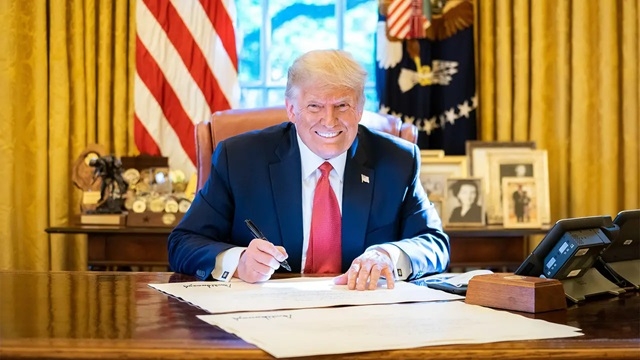"Trump's $5 Million 'Gold Card' Visa: What You Need to Know"
"Trump"s $5 Million "Gold Card" Visa: What You Need to Know"

President Donald Trump recently announced plans to introduce a new “gold card” visa, offering a direct path to U.S. citizenship for a $5 million investment. This initiative is set to replace the existing EB-5 visa program, which has been in place for over 35 years. The move has sparked concern among Indian nationals who have been waiting years for their green cards.
What is the ‘Gold Card’ Visa, and How Does it Differ from a Green Card?
Commerce Secretary Howard Lutnick stated that the “Trump Gold Card” visa would replace the EB-5 investor visa within two weeks. Originally created by Congress in 1990, the EB-5 visa was designed to encourage foreign investment in the U.S. by requiring investors to contribute at least $1 million to a company that creates at least 10 jobs.
The new gold card visa, however, would raise the investment requirement to $5 million, eliminating the job creation requirement that the EB-5 mandates. Despite the higher cost, the gold card will offer an immediate path to permanent legal residency (green card), and eventually, citizenship. Unlike the EB-5, the gold card is set to eliminate the backlog and streamline the process.
Key Differences Between the EB-5 Visa and the Trump ‘Gold Card’ Visa
| Feature | EB-5 Visa | Trump Gold Card Visa |
|---|---|---|
| Investment Required | $800,000 – $1.05 million | $5 million |
| Job Creation Requirement | Must create 10 U.S. jobs | No job creation requirement |
| Path to Citizenship | 5-7 years | Immediate pathway |
| Backlog for Indians | High backlog (7-10+ years) | No backlog (direct purchase) |
How Will the Gold Card Affect Indian Nationals Waiting for Green Cards?
For India’s wealthiest individuals, Trump’s proposed gold card visa could be a game-changer. It offers a much faster and simpler route to U.S. residency compared to the EB-5 investor visa or the lengthy H-1B to green card process. However, the catch is the hefty $5 million price tag, which may limit access to only India’s super-rich elite.
This proposal raises concerns for many Indian nationals who have been in the queue for years under the EB-2 and EB-3 categories, where wait times can stretch over a decade due to high demand.
Will the Gold Card Replace the EB-5 Investor Visa Program?
Yes, if the gold card visa is implemented as proposed, it will replace the EB-5 investor visa program. The Trump administration sees this as a way to reduce bureaucracy and fraud that has plagued the EB-5 program, while also generating additional revenue through the sale of visas.
Can Indians Currently on H-1B or EB-2/EB-3 Visas Apply for the Gold Card?
Yes, Indians currently on H-1B or EB-2/EB-3 visas can apply for the gold card, provided they can afford the $5 million investment. This new visa would serve as a shortcut to U.S. citizenship, bypassing the traditional requirements of job creation and business setup, which have often caused delays for Indian nationals.
Alternative U.S. Immigration Options for Indian Nationals
Since the gold card visa may not be accessible to most Indians due to its high cost, here are some alternative options to consider:
EB-5 Visa (if available before the gold card takes effect)
- Investment: $800,000 (in targeted employment areas)
- Pros: Green card in 3-5 years (faster than EB-2/EB-3)
- Cons: Requires job creation, longer wait times if demand increases
O-1 Visa (for individuals with extraordinary abilities)
- Ideal for professionals in fields like technology, research, arts, and business.
- Can lead to an EB-1 green card, which has no backlog for Indian nationals.
L-1 Visa (for business owners and executives)
- Allows multinational executives and managers to transfer to the U.S.
H-1B to EB-2/EB-3 (skilled worker route)
- Common for Indian tech workers on H-1B visas.
- Drawback: Long wait times, sometimes spanning decades.
Conclusion
While the Trump administration’s proposed $5 million gold card visa offers a quicker path to U.S. residency, it is unlikely to be accessible to most Indian nationals due to its high cost. For those who can afford it, however, the gold card could serve as a more direct and streamlined alternative to the traditional visa processes. For the majority, exploring other options such as the EB-5 or O-1 visas may still be the most feasible way forward.

